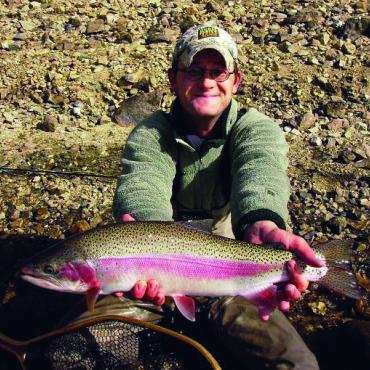Draggin' and Snaggin'
Eastern Montana has long been famous for its abundance of paleontological discoveries; numerous whole skeletons from various species of dinosaurs have been found in the bluffs and badlands along the Missouri River. Therefore it should come as no surprise that a living specimen from that ancient age still plies the depths of the Big Muddy and her tributaries.
This living specimen is of course Polyodon spathula, more commonly known as the paddlefish. This Montana native derives its name from the long spatula-like “paddle” that protrudes from its snout. This protuberance, called a rostrum, is usually longer than the head and can account for as much half of the fish’s overall length. While not related to sharks, paddlefish and sharks do share some common characteristics—mainly that their skeletons are almost entirely composed of cartilage. This fact might explain why these holdovers from the late Cretaceous period can grow to such large sizes. The Montana state record, caught in 1973, was 77 inches long and weighed just slightly over 142 pounds.
It might be due to the paddlefish’s potential size, or perhaps it’s the thrill of pulling something so alien from the muddy, churning waters; whatever the reason, hordes of anglers flock to the boulder-strewn banks of the Yellowstone and Missouri each May to try and snag one of these monsters.
Season
While the paddlefish has maintained sustainable numbers here in The Treasure State, it is listed in many parts of the country as a species of special concern. Therefore Montana Fish, Wildlife & Parks (FWP) sets strict seasonal, day, and time limits for these fish. Usually paddlefish season starts May 15 and runs through June 30. The bag limit for paddlefish is one fish, per angler, per year. Depending on the area of harvest, these fish will need to be tagged with color-coded tags specific to the area and waterway. Paddlefish regulations are specific and heavily enforced. For more information on the 2013 season, visit fwp.mt.gov.
Location
Paddlefish live in the slow-flowing, coffee-colored waters of the lower Yellowstone and Missouri Rivers. Anything below Fort Peck Dam is a safe bet, and there are fishing access sites too numerous to mention. Many of these sites are located close to camping and other accommodations. Fishing for paddlefish is time-consuming—plan on using up an entire weekend, and make sure to schedule in the windshield time. Four or five hours of drive time from Bozeman is usually the norm on these trips, but a good spot and a buddy or two can make the trip a memory for life.
Tackle
Leave the light stuff at home! Heavyweight surf casting rods and reels are the go-to gear. If it looks on the big side for tuna it should be just right for paddlefish. Paddlefish feed by opening their cavernous mouths and filtering in micro-plankton from the water, and consequently they don’t exactly bite. Snagging is the one and only method to catch these freshwater denizens. Spool up with nothing lighter than 40-pound test. 0-sized and bigger weighted treble hooks, and sinkers the size of sparkplugs will also help get the hooks into the fish. If the snag-and-drag method seems a bit unsporting, you can also try to snag a paddlefish using a heavy saltwater-grade sink-tip fly line and an 8- to 14-weight standard or two-handed fly rod. A short length of 40-pound leader and a 0-sized treble hook may do the trick.
Feast
After the substantial investment of time and other resources involved in the average paddlefish snagging adventure, it’s fulfilling to know that they make great table fare. Second only to sturgeon, the paddlefish produces some of the finest caviar in the world. When brined and shucked of the connective tissue, paddlefish roe can be succulent on rye cocktail bread or even on Doritos. Paddlefish meat can be prepared in much the same way any as large species of fish. Slow, over low heat is always the best when grilling or roasting. If deep-frying seems truer to your style, an egg and potato-flake batter is sure to please even the pickiest of fish feasters.
As with any sporting endeavor, a successful paddlefish trip requires a good amount of preparation and research. Study the regulations carefully, talk to old-timers, buddies, anyone who has done it before. Any information you can gather before heading out can be helpful. For more information on paddlefish fishing and trip planning ideas, visit fwp.mt.gov. Another great resource is the Glendive, Montana Chamber of Commerce, whose website is glendivechamber.com. With a little research and some planning you could bank one of the oldest living game species in North America.
Illustration by Tim Knepp, Photo by Andrew Mckean/Montana FWP














